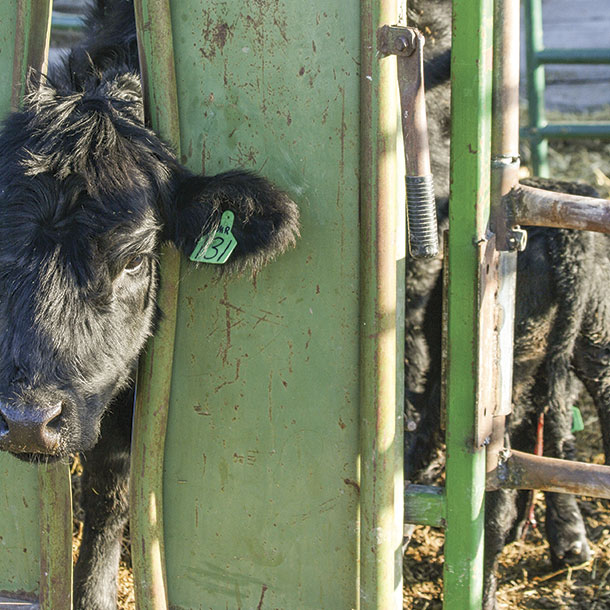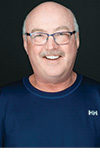Choices and purpose
There are many different choices including models with stanchions, panels and headgates, with or without tub, straight or winding alleyways, and gates pointing in every direction, including up. Livestock equipment company advertisements spout words like versatility, ease, optimum, comfort, user-friendly, automatic, self-catch, dual-split, safety and heavy-duty. One even proclaims that calving heifers will be a breeze.
When considering a new calving pen, it is essential to remember what their purpose is – to deliver a healthy, live calf; continue the fertility of the mother; reduce calving pen stress and ensure a safe area for both the handler and the mother.
Jennifer Woods, a livestock handling specialist, urges producers not to be overwhelmed by all the choices. “We’ve gotten to the point where there are so many designs on the market now, but I don’t like to call out one brand over another. Make your checklist of what you look for, rather than doing a brand promotion.”
And before producers get too specific and make a purchase, she asks them to consider the philosophy of the system. “Match the handling design to an animal’s natural instinct. I always tell people to envision how water would flow through their system. That’s how cattle will move through it.”
Animal and handler safety
 Safety for both the animal and the handler is vital. “The calving pen is one of the most dangerous places you can be,” says Woods. She explains that the weak spot on most systems is the gates and their locking mechanisms. Slam latches are a good feature on every panel around the headgate area as there are times when gates need to be closed in a hurry. “Where people get hurt the most in calving pens is when gates hit them, don’t open when they should or when handlers reach through the bars and get kicked or pinned by the cow. Secure and safe latches are a must.”
Safety for both the animal and the handler is vital. “The calving pen is one of the most dangerous places you can be,” says Woods. She explains that the weak spot on most systems is the gates and their locking mechanisms. Slam latches are a good feature on every panel around the headgate area as there are times when gates need to be closed in a hurry. “Where people get hurt the most in calving pens is when gates hit them, don’t open when they should or when handlers reach through the bars and get kicked or pinned by the cow. Secure and safe latches are a must.”
Woods reminds her clients to look at the big picture: make the system work for what they want to accomplish and match the infrastructure. Designs can feature entrance from all sides in square or rectangular models. There are also rounded pens with squeeze gates that latch at close intervals along the outside edge. This model eliminates the possibility of the cow getting at the handler in an open corner space before the squeeze panel can be latched. “It has to work for what you are doing. You need to be able to get to the cow safely and be out of harm’s way and not get trapped,” she says.
And she has some commonsense advice when it comes to safety. “Always, always be alert! Don’t assume you know what the animal is going to do. Always make sure you have a way out, and never put an animal between you and that escape route.”
Usability and maintenance
Usability of the equipment is also very important to Woods. “I do like self-catching headgates, but make sure they are of good quality and the mechanisms work well and are easy to handle. Self-catching is much better for people working alone, which is often the case.” Most headgates feature adjustable side panels to accommodate different animal sizes, and some include a guard over the release catch to keep an animal from throwing their head and inadvertently opening the mechanism. There are fold-down flooring pieces and overhead adjustable latching bars to keep animals from springing the squeeze panel toward the handler.
Woods stresses that a calving system, pen and headgate work quietly and be regularly maintained. “The quieter they are, the calmer the animals will be. And a key part of usability and quietness is regular maintenance. A lot of people fail with this.”
Flooring and isolation
Calving pen flooring is another area where she sees a lot of producers fail. “Generally, if animals don’t feel secure in their footing, they won’t settle,” says Woods. It’s common for a cow to continually switch between standing and lying in the 48 hours leading up to giving birth, with most changes occurring in the last six hours. The floor should provide proper traction and stability but also offer a comfortable surface for lying, walking or standing. Grooved concrete, sand and rubber mats covered with thick layers of straw or sawdust are good options with some studies claiming that given the choice, cows will usually choose either concrete or sand with a thick clean layer of straw.
To the rear of the headgate, some models feature a permanent mesh floor to give the animal more stability during a difficult birthing. “Non-slip flooring in the calving pen is never loose straw on top of smooth concrete. And keep it clean. You lose the non-slip quality when a bunch of manure piles up in it,” says Woods.
Cows naturally seek seclusion and isolation when giving birth, but the subject can have differing views. “Some cows really don’t care if they are alone, but some have a very strong herd instinct and have a lot of trouble settling down to have a calf,” says Woods. If it’s a reasonably tempered cow, try to move her into a pen one to two days in advance. Plywood panels or tarps can be added to pen dividers or gates to minimize distractions and give privacy.
But for cows that won’t settle down, Woods suggests bringing another animal into an adjacent pen. “Cattle usually stay calmer if they have a buddy.”
Calving pens and the accessories they come with are only a part of a larger puzzle. The design chosen by a producer must fit with existing infrastructure. Even then it will only be as successful as the work processes that support it, such as strong sanitation procedures and personnel trained in proper hygiene and delivery-assistance procedures. ![]()
PHOTO: A calving system, pen and headgate should work quietly and be regularly maintained. The more quiet the system, the more calm the dam will be. Photo by Paul Marchant.
Bruce Derksen is a freelance writer based in Lacombe, Alberta, Canada.








